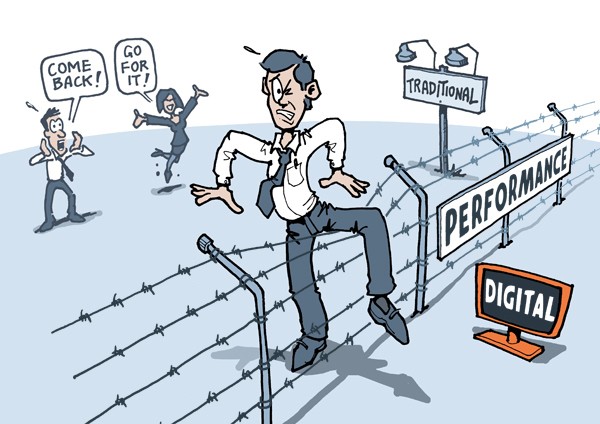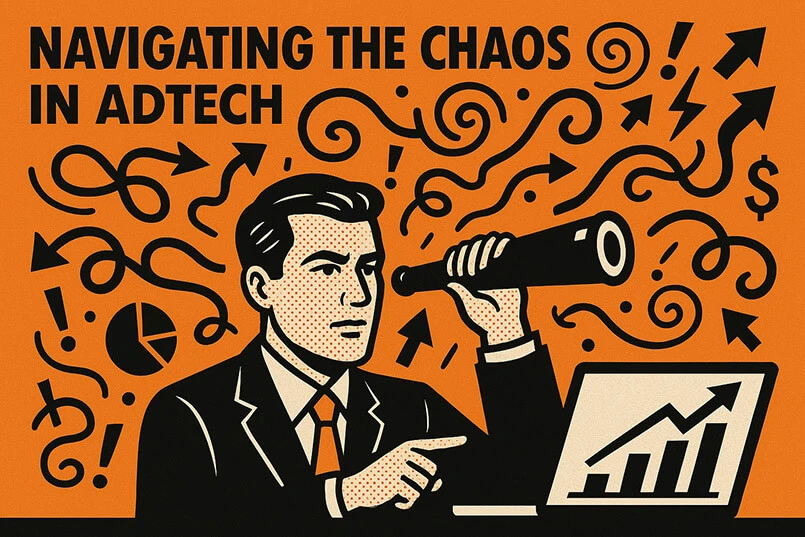I wonder how many marketers feel like this. My old friend and terrific illustrator Roger Harvey, drew this cartoon for me and I think it captures how many marketers find themselves today. One foot in the traditional marketing camp they have lived in for most of their careers and one foot in the digital camp, which is not living up to the expectation or the promise.
Surrounding them are the vendors, agencies, suppliers and media encouraging them to “Go forward” or to “Pull back” depending on their vested interest. Meanwhile the marketers feel like they are trapped in a precarious position feeling that if they stand still too long they will be left behind and if they go forward or back they could be seen to fail.
What they do know is they need to make a decision one way or the other as in the meantime they will continue to haemorrhage budget on both their traditional and their digital strategy. So how did they get here and more importantly how can they get out and avoid being trapped?
How did we get here?
There are many reasons marketers end up in this situation. Understanding these is the first step to finding the best way out of the situation, or even better, making sure you avoid it completely.
1. Assuming traditional and digital work the same way
There is a very senior marketer who got stuck here because he simply transitioned their spend from their traditional media to their digital media. Working for a services company, they believed that the way digital advertising worked was exactly the same as traditional advertising. That is, instead of thinking about engaging the audience, he focused on audience delivery, measuring and paying for impressions with excellent CPMs (cost per thousand) in digital over the increasing price of media in his traditional channels.
His approach was driven by a belief that the role of the advertising was to drive awareness and perception of the brand. Over time the digital budget increased at the expense of the traditional budget, but the results were not being delivered in the form of new customer, increased sales or revenue. In fact financially he felt it was a huge failure. But he could not go back to his traditional media options as he had seen the performance here fall rapidly too.
2. Treating this as a marketing only opportunity
Technology is not just changing marketing and advertising. Technology is impacting all areas of business. E-commerce is the most obvious area where all parts of the organisation are engaged from operations to finance, marketing and distribution. But other areas are also increasingly in dispute. Another area in hot dispute is social media with corporate affairs, sales and marketing all participating and claiming responsibility.
With so many stakeholders all embracing, or at best, utilising technology for engaging with the customer, it can often lead to either conflict or roadblocks. Therefore many marketers will often try and develop their digital strategy in isolation, rather than collaborating with the other internal stakeholders. While it means the marketer can develop a quite effective digital advertising campaign, it limits the opportunities to engage the customer in the brand experience.
3. Not having the organisation aligned to the process
With so many suppliers and agencies engaging with the marketers, and all pushing the latest technology or digital opportunity, marketers are increasingly leading the technology investment within organisations (Some have predicted the CMO will outspend the CIO on technology investment).
Marketing tools and technology is one the the fastest growing areas of technology, driven by the consumer embracing technology and in the process handing over so much data and information on their behaviour and preferences in the process.
The problem is that often the marketing investment is out of step with the rest of the organisation. While marketing may be leading the process, it is continually limited by either being misaligned or operating ahead of the organisation’s strategy. This includes having effective infrastructure and processes to collect, manage and utilise customer data.
Moving from confusion to clarity
The solution to finding yourself in this position is not easy, but it is achievable. In fact, we have recently published a 27,000 word Ultimate Guide to Digital Marketing in a Data-driven World which provides a 100-day plan on how to go from confusion to clarity within your organisation.
It is a matter of making sure your digital and technology integration is aligned and integrated to the overall business strategy, not just the marketing strategy. Of course it can be argued that the marketing strategy is aligned to the business strategy, but just to make sure, we recommend aligning to both the business and marketing objective.
We are increasingly working with a wide range of marketers across services (financial and telco), consumer goods, automotive, media and the like to not only align their external suppliers and agencies, but also assist in designing and managing the transformation internally to achieve this alignment.
It is this experience we have captured in the Ultimate Guide t0 Digital Marketing in the Data-driven World. If you are interested, you can get your free copy here. Or we are happy to meet and discuss the particular situation you are facing. Confidentially, of course.





3 thoughts on “How to avoid the traditional to digital marketing transition trap”
Nail. Head. Hit! Another excellent summary of complex and vital business challenges.
Thanks David. Again, the trouble is too often we are so busy speaking different languages that perhaps if we just all took the time to sit down and speak the one language (business) then a lot of these issues would be resolved. After all, digital and data, marketing and sales, customer experience management and customer relationship management are, in this context, all just disciplines applied to achieve a commercial outcome.
I enjoyed your post, Darren. As a content writer, a big cause of frustration is highly enthusiastic clients whose excitement wanes early. And the reason is usually, as you say, that they don't have buy-in from other key people in their organisation. With one client, I'm still waiting for a case study to be approved 6 months after I wrote it — my contact is waiting for an engineer to get around to editing it. Thankfully, I've been paid, but they are the kind of client I can do without.
Comments are closed.